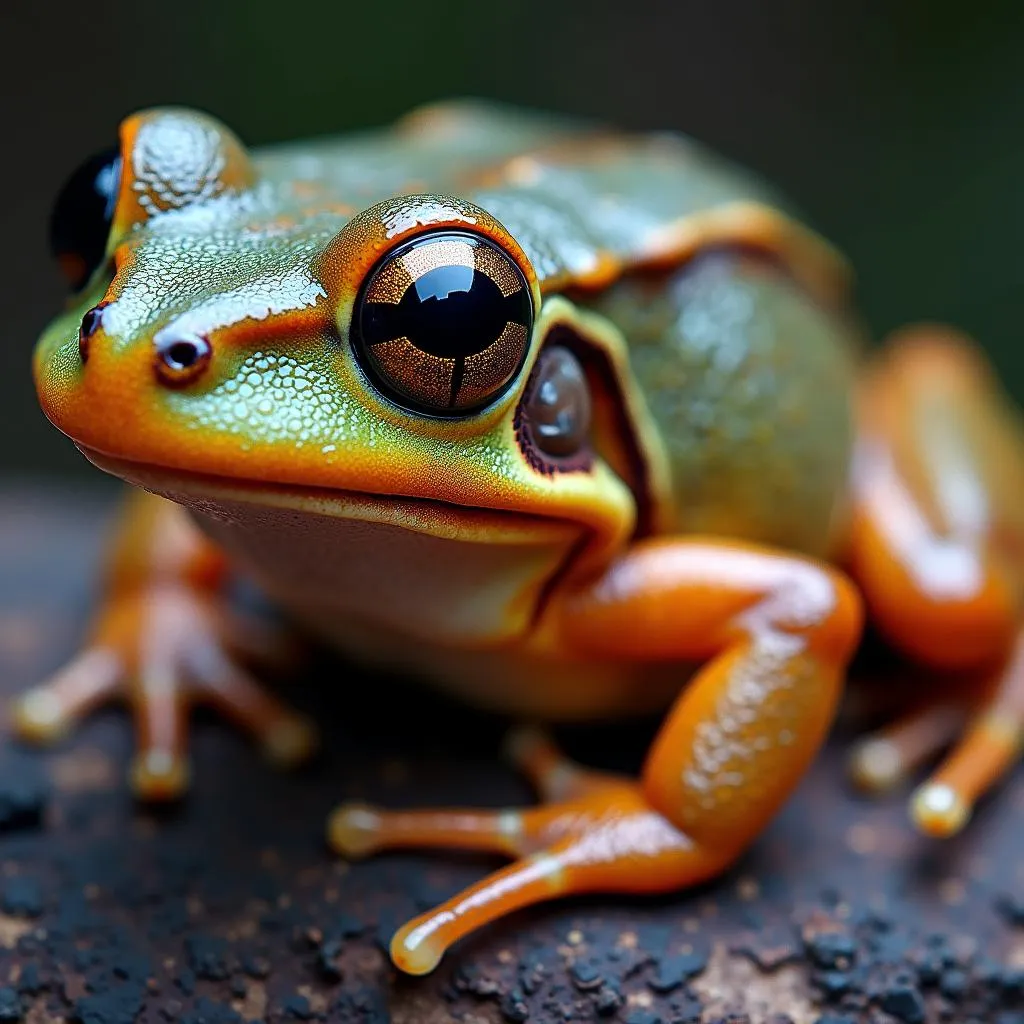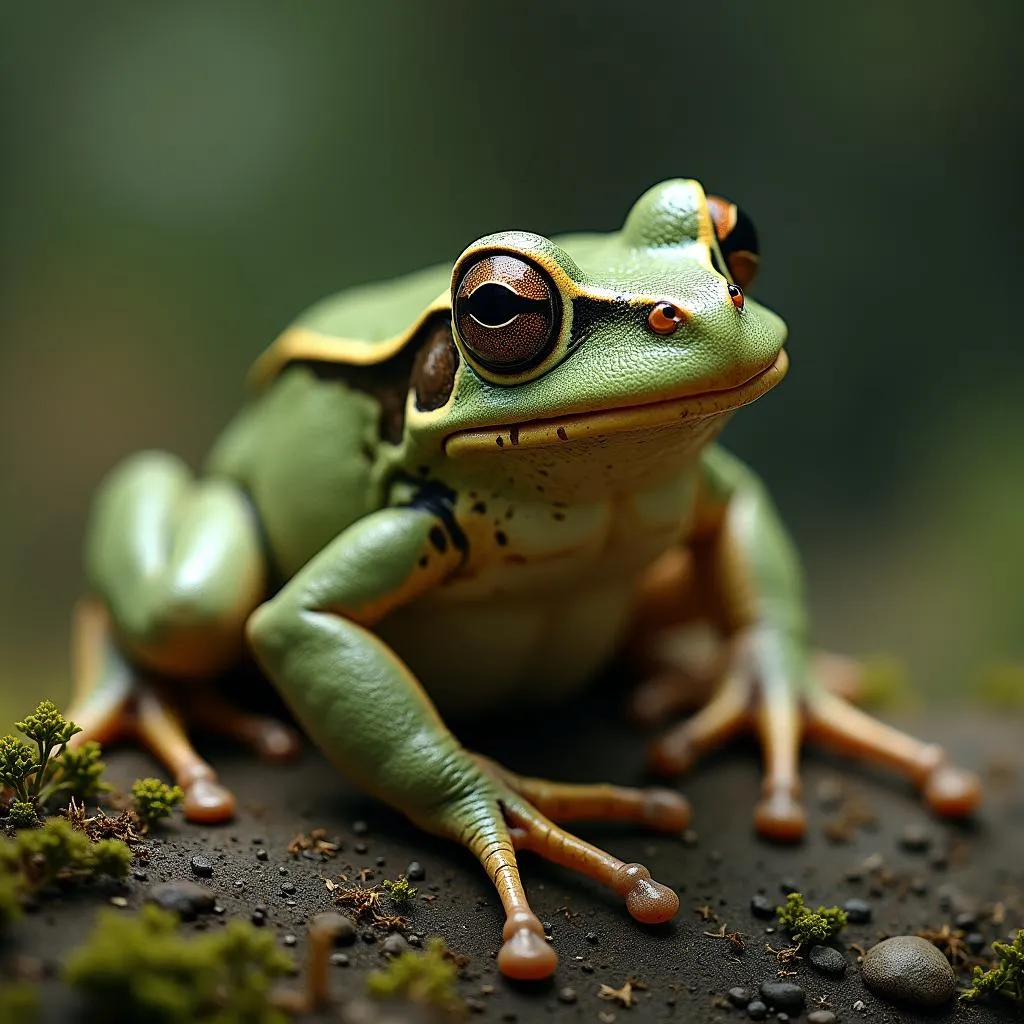Frogs are fascinating creatures known for their unique abilities and characteristics, but can they change color like chameleons? The answer isn’t a simple yes or no. While frogs can’t drastically change their hues like chameleons, they possess some color-changing capabilities, albeit for different reasons.
Understanding Frog Skin
A frog’s skin isn’t just a covering; it plays a crucial role in its survival. It aids in respiration, absorbs water, and acts as camouflage. The color of a frog’s skin is determined by specialized cells called chromatophores, which contain pigments.
 Frog Skin and Chromatophores
Frog Skin and Chromatophores
Types of Chromatophores
There are three main types of chromatophores in frog skin:
- Xanthophores: These cells contain yellow, orange, or red pigments.
- Iridophores: These cells contain reflective pigments that create iridescent hues like green and blue.
- Melanophores: These cells contain melanin, the pigment responsible for brown and black coloration.
The interaction between these chromatophores, along with the amount of pigment present, determines a frog’s overall color.
Color Change Mechanisms
While frogs cannot change their base color, they can alter their shade and intensity. This is achieved through two primary mechanisms:
-
Physiological Color Change: This type of change occurs in response to environmental factors like temperature, light, and humidity. For instance, a frog might become darker to absorb more heat on a cool morning or lighter to reflect sunlight on a hot afternoon. This change is relatively slow and is controlled by hormones.
-
Morphological Color Change: This type of change is less common and involves a more gradual alteration in the distribution of pigments within the chromatophores. It can occur over days or weeks and is often associated with factors like stress, health, or breeding season.
 Tree Frog Camouflaged on a Leaf
Tree Frog Camouflaged on a Leaf
Camouflage and Communication
The primary function of color change in frogs is camouflage. By adjusting their shade to match their surroundings, frogs can blend in and avoid detection by predators. Additionally, some frog species use color change as a form of communication. During mating season, males might display brighter colors to attract females or to warn off rivals.
Examples of Color-Changing Frogs
-
Gray Tree Frogs (Hyla versicolor): These frogs are masters of camouflage and can change their color from gray to green to brown depending on their environment.
-
Panamanian Golden Frogs (Atelopus zeteki): These critically endangered frogs are known for their bright yellow coloration, which serves as a warning to predators of their toxicity. They can also darken their skin when threatened.
Frogs vs. Chameleons: Color-Changing Champions
While both frogs and chameleons are known for their color-changing abilities, their mechanisms and purposes differ significantly. Chameleons possess specialized cells called iridophores that can rapidly change the arrangement of pigments, allowing for a wide range of color transformations. This ability is primarily used for communication and social signaling rather than camouflage.
Conclusion
So, while frogs might not possess the dramatic color-changing abilities of chameleons, their more subtle adaptations are no less remarkable. These changes play a crucial role in their survival, allowing them to blend seamlessly with their surroundings, regulate their body temperature, and even communicate with each other.
FAQs
1. Do all frogs change color?
While all frogs have chromatophores, the extent of their color-changing abilities varies. Some species exhibit more dramatic changes than others.
2. How long does it take for a frog to change color?
The speed of color change depends on the type and trigger. Physiological changes can occur within minutes to hours, while morphological changes take days or weeks.
3. Can frogs change color to any color?
No, frogs cannot change color to any arbitrary hue. Their color palette is limited by the types of pigments present in their chromatophores.
4. Do frogs change color when they are scared?
Some frogs might darken their skin when stressed, but this is not a universal response.
5. What is the purpose of a frog’s bright colors?
Bright coloration in frogs often serves as a warning to predators, signaling toxicity or unpalatability.
 Poison Dart Frog with Vibrant Colors
Poison Dart Frog with Vibrant Colors
Need Help?
Have more questions about frogs or need help with your next painting project? Contact us at 0373298888, email us at [email protected], or visit our store at 86 Cầu Giấy, Hà Nội. Our team is available 24/7 to assist you!

